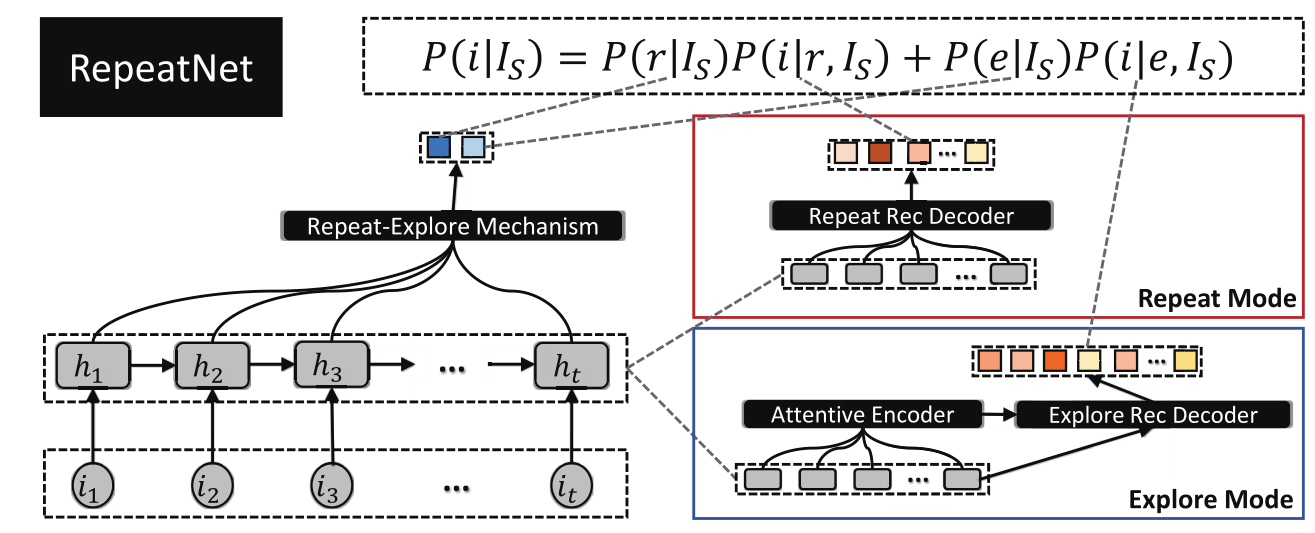RepeatNet¶
Introduction¶
Title: RepeatNet: A Repeat Aware Neural Recommendation Machine for Session-based Recommendation.
Authors: Pengjie Ren, Zhumin Chen, Jing Li, Zhaochun Ren, Jun Ma, Maarten de Rijke
Abstract: Recurrent neural networks for session-based recommendation have attracted a lot of attention recently because of their promising performance. repeat consumption is a common phenomenon in many recommendation scenarios (e.g.,e-commerce, music, and TV program recommendations), where the same item is re-consumed repeatedly over time. However, no previous studies have emphasized repeat consumption with neural networks. An effective neural approach is needed to decide when to perform repeat recommendation. In this paper, we incorporate a repeat-explore mechanism into neural networks and propose a new model, called RepeatNet, with an encoder-decoder structure. RepeatNet integrates a regular neural recommendation approach in the decoder with a new repeat recommendation mechanism that can choose items from a user’s history and recommends them at the right time. We report on extensive experiments on three benchmark datasets. RepeatNet outperforms state-of-the-art baselines on all three datasets in terms of MRR and Recall. Furthermore, as the dataset size and the repeat ratio increase, the improvements of RepeatNet over the baselines also increase, which demonstrates its advantage in handling repeat recommendation scenarios.

Running with RecBole¶
Model Hyper-Parameters:
embedding_size (int): The embedding size of users and items. Defaults to64.hidden_size (int): The number of features in the hidden state. Defaults to64.joint_train (bool): The indicator whether the train loss should add the repeat_explore_loss. Defaults toFalse.dropout_prob (float): The dropout rate. Defaults to0.5.loss_type (str): The type of loss function. If it set to'CE', the training task is regarded as a multi-classification task and the target item is the ground truth. In this way, negative sampling is not needed. If it set to'BPR', the training task will be optimized in the pair-wise way, which maximize the difference between positive item and negative item. In this way, negative sampling is necessary, such as setting--neg_sampling="{'uniform': 1}". Defaults to'CE'. Range in['BPR', 'CE'].
A Running Example:
Write the following code to a python file, such as run.py
from recbole.quick_start import run_recbole
parameter_dict = {
'neg_sampling': None,
}
run_recbole(model='RepeatNet', dataset='ml-100k', config_dict=parameter_dict)
And then:
python run.py
Notes:
By setting
reproducibility=False, the training speed of RepeatNet can be greatly accelerated.
Tuning Hyper Parameters¶
If you want to use HyperTuning to tune hyper parameters of this model, you can copy the following settings and name it as hyper.test.
learning_rate choice [0.001,]
embedding_size choice [64]
joint_train choice [False,True]
dropout_prob choice [0.5,]
train_batch_size: 2048
Note that we just provide these hyper parameter ranges for reference only, and we can not guarantee that they are the optimal range of this model.
Then, with the source code of RecBole (you can download it from GitHub), you can run the run_hyper.py to tuning:
python run_hyper.py --model=[model_name] --dataset=[dataset_name] --config_files=[config_files_path] --params_file=hyper.test
For more details about Parameter Tuning, refer to Parameter Tuning.
If you want to change parameters, dataset or evaluation settings, take a look at